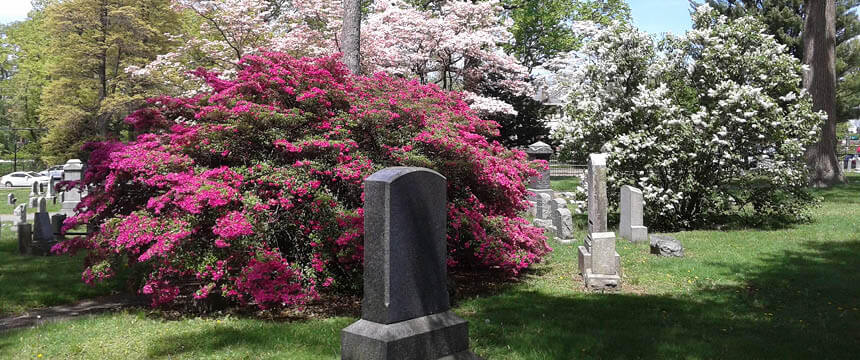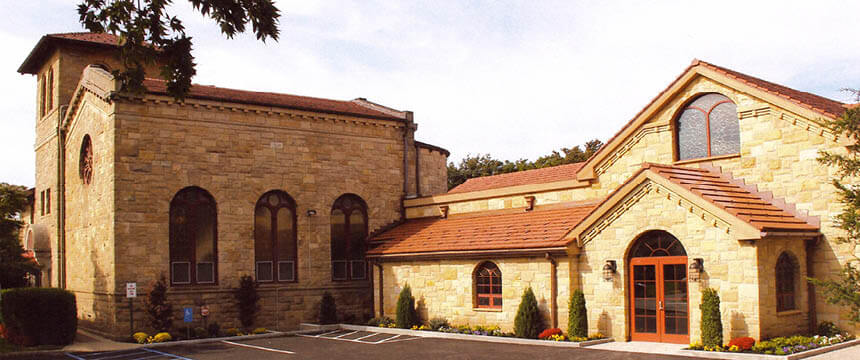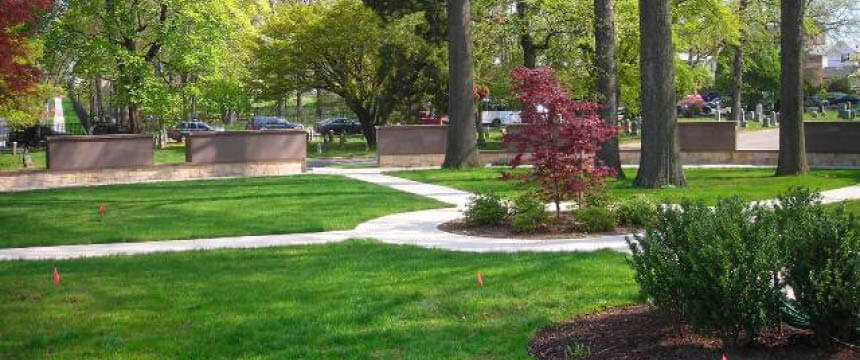
The team at Flushing Cemetery knew they had to change their soon-to-be obsolete operating system, so when the time came, they made the conscious decision to also change how they were going to use it. By adopting a complete cemetery management system, Flushing Cemetery can now take a burial and, from start to finish, do all the paperwork within their system, streamlining processes and increasing efficiency.
‘The Wonderland of a Million Blooms’
Flushing Cemetery is a non-profit, non-sectarian cemetery serving all faiths within Flushing, Queens. Founded in 1853, Flushing Cemetery is 75 acres and is home to a large variety of trees and shrubs, which earned it the name ‘the wonderland of a million blooms.’ Having conducted a recent tree inventory five years ago, the cemetery was found to be the only place in New York state to give a particular home to some tree species, indicating its horticultural significance.
The cemetery team is composed of six people in the office, and twelve employees outside taking care of the grounds. Flushing is noted for famous burials of jazz greats, including Louis Armstrong, Dizzy Gillespie, and also Johnny Hodges.
Commenting on what makes Flushing Cemetery unique, General Manager John Helly said: “We are a rural landscape cemetery, so there are a lot of hills and there is a nice flowing appearance to the cemetery. It’s not generic in any way. The older sections blend in with the newer sections very nicely.” It is also situated less than 15 miles from Manhattan, which, according to Helly, is “one of the larger selling points for us,” with Flushing Cemetery well-situated to the public transportation system.
Land is tight, so creativity is key
An ongoing issue for the majority of cemeteries is a lack of space. As an older cemetery, this is also the case at Flushing Cemetery. Therefore, the cemetery team has been creative with the land they have, and by closing off roads no longer used for transportation, the space is now used for burials. John Helly has worked at Flushing Cemetery for thirty years, with the last ten years as general manager, and they have closed off five roads already.
In addition, Helly highlights that the two current biggest market forces are green burials and natural organic reduction. Although Flushing Cemetery does not have the available space to dedicate land specifically to those two bigger forces, they have explored how to best accommodate the largest change for cemeterians – the increased cremation rate.
As Helly indicates, “the biggest trend which everyone’s been talking about for many, many years, is how high the cremation rate is going. It’s getting close to 50 percent now, so most cemeteries are realising that that’s probably just going to keep increasing.” This led Flushing Cemetery to expand their provision of niches, which have become an especially popular choice. “Families are leaning towards cremation more, and with space being so tight, it’s easier to build an area that will hold 3000 niches as opposed to an area that’s going to hold 3000 caskets,” adds Helly.

The Memorial Chapel Mausoleum
Twenty years ago, Flushing Cemetery added a very small wing to their office building called the Memorial Chapel that was home to just a few hundred niches. This was their first experience in offering columbarium burials, also known as niche burials. Having been very popular, they opened up a much larger extension in 2019 that they called the Memorial Chapel Mausoleum. As opposed to having just a few hundred niches, the new building has almost 3400 niches, a combination of glass and marble. This was in addition to their pre-existing niche garden, referred to as the Memorial Garden.
Whereas a lot of the cemeteries in the area had already built mausoleums for crypts, Flushing Cemetery was keen for this building to concentrate on niches, glass niches in particular, which are the preference of the local community. However, they also included 168 casket spaces to see how families reacted to crypts. “The exciting thing is that it was our first time offering full-size casket interments inside a building to families. So that was the most interesting part of it that we were looking to see,” adds Helly.
Nevertheless, once a plot at Flushing Cemetery is sold, whether in the Mausoleum or a plot outside, it’s maintained forever. Helly recalls an example of this, stating: “A family purchased a grave 30 years ago for $3,000, a grave that now costs almost $15,000, so we’re not making any more money on that grave, but we are maintaining it forever. You have limited inventory, but you have to maintain it forever.”
Flushing Cemetery will always make sure that the building is well-run and the landscape is well-kept. And with this additional responsibility comes a desire to maximize efficiency through a complete cemetery management system.
Boosting efficiency through better cemetery software
Initially, Flushing Cemetery began using software to keep track of their special care accounts called endowment accounts. However, they realized that there were numerous other tasks they could be using it for to develop a complete management system, “not only to work with these endowments, but to use it for almost everything in the office,” Helly says.
Whilst some providers were able to provide office processes, they did not offer financial programmes as part of their offering. As Helly explains: “OpusXenta had a programme that really took care of everything that we were looking for.” As a result, the team at Flushing Cemetery are now able to handle all paperwork within their system, making their office more efficient in the process.
“Cemeteries, it’s an old school business. People will laugh about using a typewriter, index cards, or paper maps, but up until a few years ago, a lot of cemeteries were still using these methods, because we were just so used to it. But when it came time to make a decision, we knew we had to change the system,” he adds.
Speaking on how Helly came across OpusXenta’s software, he says: “A vendor was telling me that he was impressed with them, and fellow cemetarians were also telling me that they had gone with them. By just working with the people and doing the initial meetings, we got the vibe that they would be helpful and attentive. That finalized the deal. And it turned out our instincts were right.”

A Balanced Approach for the Future
It was important for Flushing Cemetery to find the right balance between the old way of keeping the warmth of the cemetery and the warmth of the grounds, but also showing people that they were thinking about the future and moving ahead technologically. According to Helly, OpusXenta was going to help them do that. “Someone who comes onto the grounds is going to see the beauty of the grounds, but then someone who deals with us – unfortunately for burial – is going to see that we have the means here to handle it respectfully and proficiently and get everything done for them as they need it. The cemetery programme like OpusXenta can help you tie those two things together,” he explains.
Flushing Cemetery will continue to use the land that they have as efficiently as possible, including future ambitions to create an outdoor crypt garden and expand the inventory of the niche garden. There are always plans to put in trees and shrubs within any of the cemetery’s new spaces, and, as Helly says, Flushing Cemetery is “always interested in the viable, productive use of limited inventory.”
